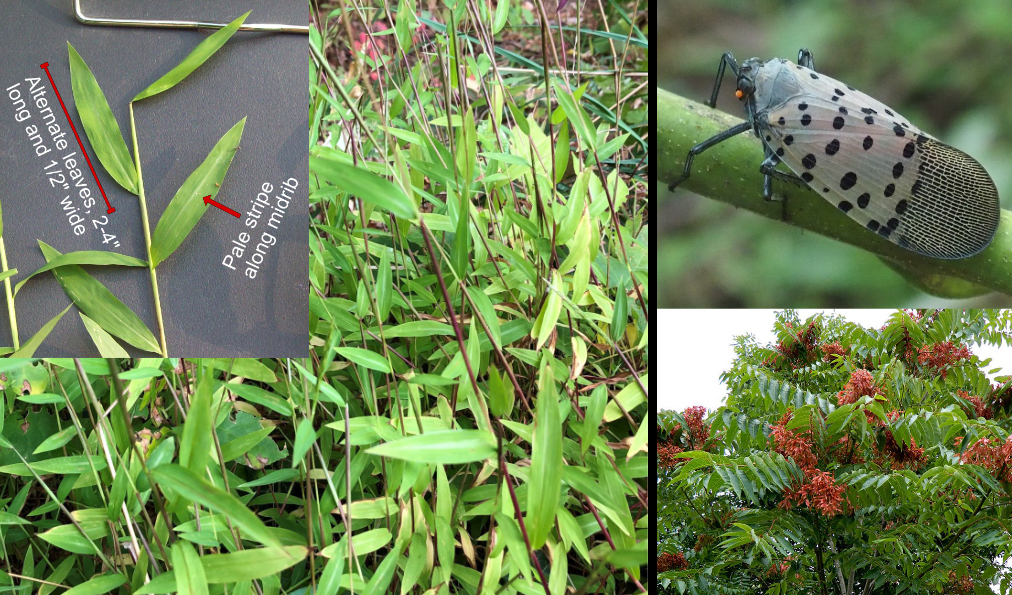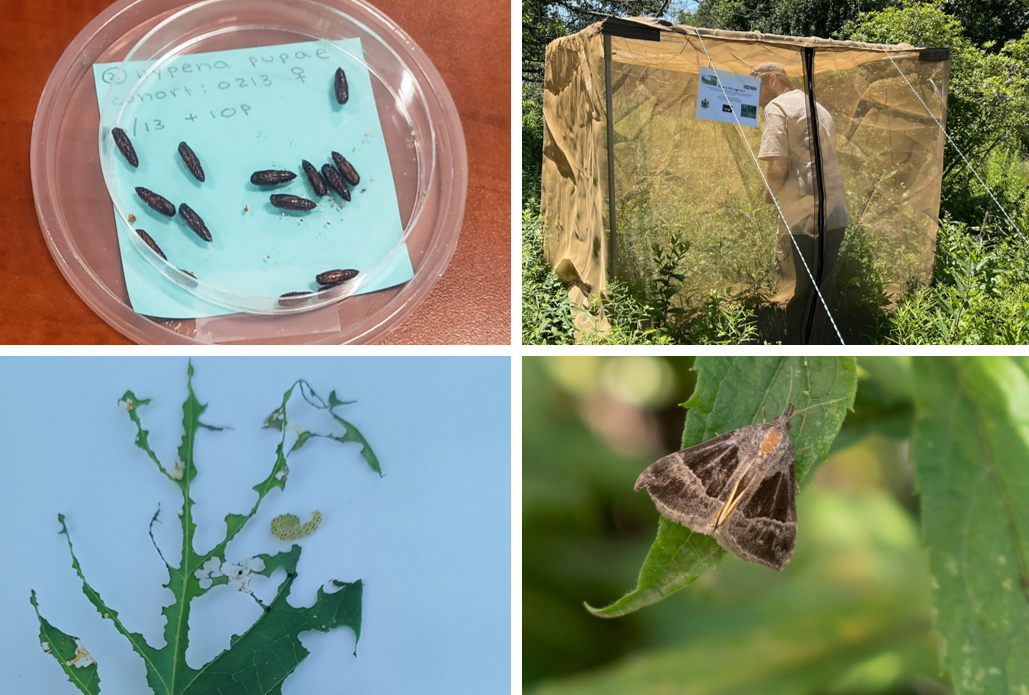MELeaf: A Newsletter From the Horticulture Program, September, 2022
In this issue:
Stiltgrass
Late summer is the best time to identify and control infestations of invasive stiltgrass (Microstegium vimineum) before plants flower and set seed. There are few locations in Maine with known populations of stiltgrass, but the plant is known to hitchhike on nursery stock and one of the infestations in Maine is at a nursery.
Stiltgrass can be difficult to distinguish from other grasses. Features to look for include:
- Leaves that alternate along the stem, are 2-4" long and ½" wide with a stripe of reflective hairs along the midrib on the leaf's top surface.
- The leaf edges and surfaces feel smooth to the touch, unlike some native grasses that have stiff hairs along the leaf edge giving them a rough or sticky feel.
- The common name "stiltgrass" comes from the plant's growth habit: it trails along the ground, branching from nodes where it produces "stilts" (roots) to support the new branches. It is shallow-rooted and easy to pull out.
- Plants flower and set seed very late in the season (September-October), much later than many other grasses. Each plant can have one to three seed spikes that resemble crabgrass.
- Stems can develop a reddish tint late in the season.
Stiltgrass is a shallow rooted annual and control methods include hand pulling, mowing and herbicides.
If you suspect you have stiltgrass in or around your nursery, please contact horticulture@maine.gov. Suspect plants in other locations (forests, roadsides, home or commercial landscapes etc.) should be reported to invasives.mnap@maine.gov.
For more information on stiltgrass and how to identify it, check out our Stiltgrass Video.
Spotted Lanternfly
Spotted lanternfly (SLF) has not yet been found in Maine, but all it takes is one egg mass attached to a plant or hardgoods in a shipment, or a hitchhiking inseminated adult female on a vehicle, for a new infestation to be started here in our state.
Now is the time to keep an eye out for adults. Adults are large, 1 inch long pinkish-tan plant hoppers with black spots on the 2/3 of the wing closest to the head and a black brick pattern on the back 1/3. When startled, SLF spreads its wings, showing its red under-wings and making it look somewhat moth-like.
SLF are generalist feeders and can be found on a wide range of plants, but some common hosts are grape, maple, apple and birch. Tree-of-heaven is a preferred host and can be a useful plant in survey efforts, but there are few known populations of this invasive plant in Maine.
If you think you see any life stages of SLF, note the location, collect a specimen or take a picture and report it to bugwatch@maine.gov. Populations of tree-of-heaven can be reported to invasives.mnap@maine.gov.
Learn more about spotted lanternfly
 A trio of invaders to look for in late summer: stiltgrass (left), spotted lanternfly (upper right), tree of heaven (lower right)
The Invasive Plant Webpage has been updated with the plants that were added to the Do Not Sell List earlier this year. We’ve also added the Watch List to the website as well. A few things to remember about the updated invasive plant list:
- The Do Not Sell List is a regulatory list; plants on this list cannot be sold in the state. Currently there are 33 species that cannot be sold and the invasive plant rule revision added an additional 30 species that cannot be sold starting January 1, 2024.
- Starting January 1, 2024 Rosa rugosa will have to be sold with a label or sign indicating that the plant may be invasive in some habitats.
- The new rule also created an Invasive Plant Watch List. The plants on this list may continue to be sold, but will be reviewed for possible inclusion on the Do Not Sell List at the next rule review in five years.
We are still currently in the process of putting together tools and outreach materials that can help spread the word to businesses selling plants, people buying plants and examples of compliant tags and signs. If you have an idea for outreach materials that could help you or your customers understand or comply with invasive plant rules, please send your ideas to horticulture@maine.gov.
The IPM Program has been investigating the viability of a caterpillar (Hypena opulenta) as a biological control for the severely invasive plant black swallowwort (Cynanchum louiseae) through a project funded by APHIS’ Plant Protection and Quarantine (PPQ) program. The tools available for management of invasive plants are limited. Mechanical removal is often environmentally disruptive and costly, while herbicide use can pose environmental and human health risks. Biological control is often the most sustainable approach; however, research is needed through field trials to make sure a released species will be effective.
Hypena caterpillars, a species originally from Ukraine, are a viable option for biocontrol as they only feed on black swallowwort and do not pose a threat to native plant species. It is important to learn if they will be able to establish in the climate in Maine, and to determine the best practices for releasing them to ensure their establishment and survival. This project is in collaboration with the University of Rhode Island (URI) Biocontrol Lab, who is providing the H. opulenta pupae for release (Photos of URI Biocontrol releases). As of 2022, the URI Biocontrol Lab has had somewhat limited success in establishing populations, with the 2019 release demonstrating higher levels of survival, but no recapture of populations.
Our two-part project during the spring and summer of 2022 involves investigating the success of a previous release site of the caterpillars in 2018 and 2021 in Ogunquit, and controlled releases of Hypena caterpillars in Harpswell. In early July, we investigated the release sites in Ogunquit along Marginal Way, looking at all swallowwort plants for tell-tale signs of caterpillar activity and staying late in the evening sampling with a black light and a sheet to try and attract the adults of the Hypena caterpillars. We did not find any caterpillar damage on plants (which have been reduced quite a bit through the work of volunteers removing seed pods) and did not find any adults. This information was important, as it helped us to modify our release strategy in Harpswell to try and ensure more survival of the caterpillars.
 Hillary Peterson (DACF IPM Entomologist) and Michael Galli (DACF Field Technician) monitor a sheet with a black light on Marginal Way in Ogunquit ME for Hypena adults. Photo by Joan Griswold.
In Harpswell, Hypena were released in cages at two locations, with two additional cages set up with no releases as controls to the study. We received pupa from the URI Biocontrol Lab in the spring and reared these pupa to adults which were released in the cages. The adult moths mated and laid eggs on swallowwort plants in the cages, and we have been monitoring the cages for caterpillars and rating the amount of feeding damage seen on the leaves. So far, things are looking good. In one of the cages, the caterpillars ate every single swallowwort leaf, so we removed the cage and let them feed on surrounding plants. In both locations, we were surprised with a second generation of adults, meaning that we released adults that laid eggs, fed, pupated, and emerged again as adult moths at these locations. We are hoping they are able to pupate before winter and survive to next year at both, and will continue monitoring the progress.
 Hypena pupa obtained from the URI Biocontrol Lab (upper left); Release cage being monitored for caterpillar activity (upper right); Black swallowwort leaf with almost complete feeding damage by Hypena caterpillars, with a caterpillar shown (lower left); surprise second generation adult Hypena moth in the cage at Lands End in Harpswell (lower right). Photos by Hillary Peterson and Michael Galli
|